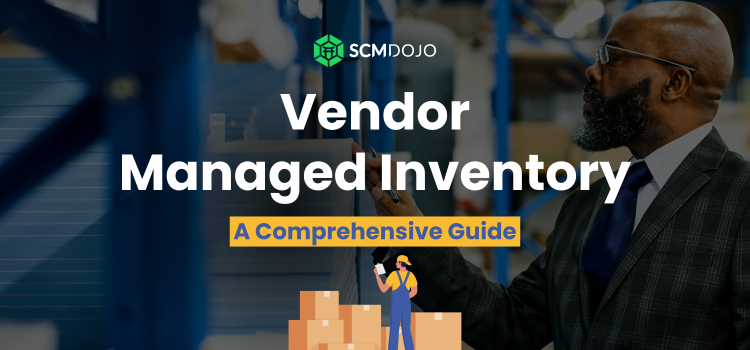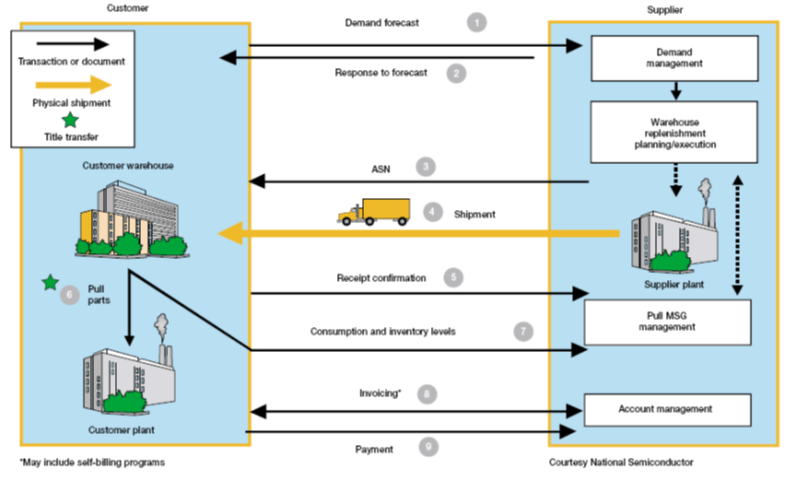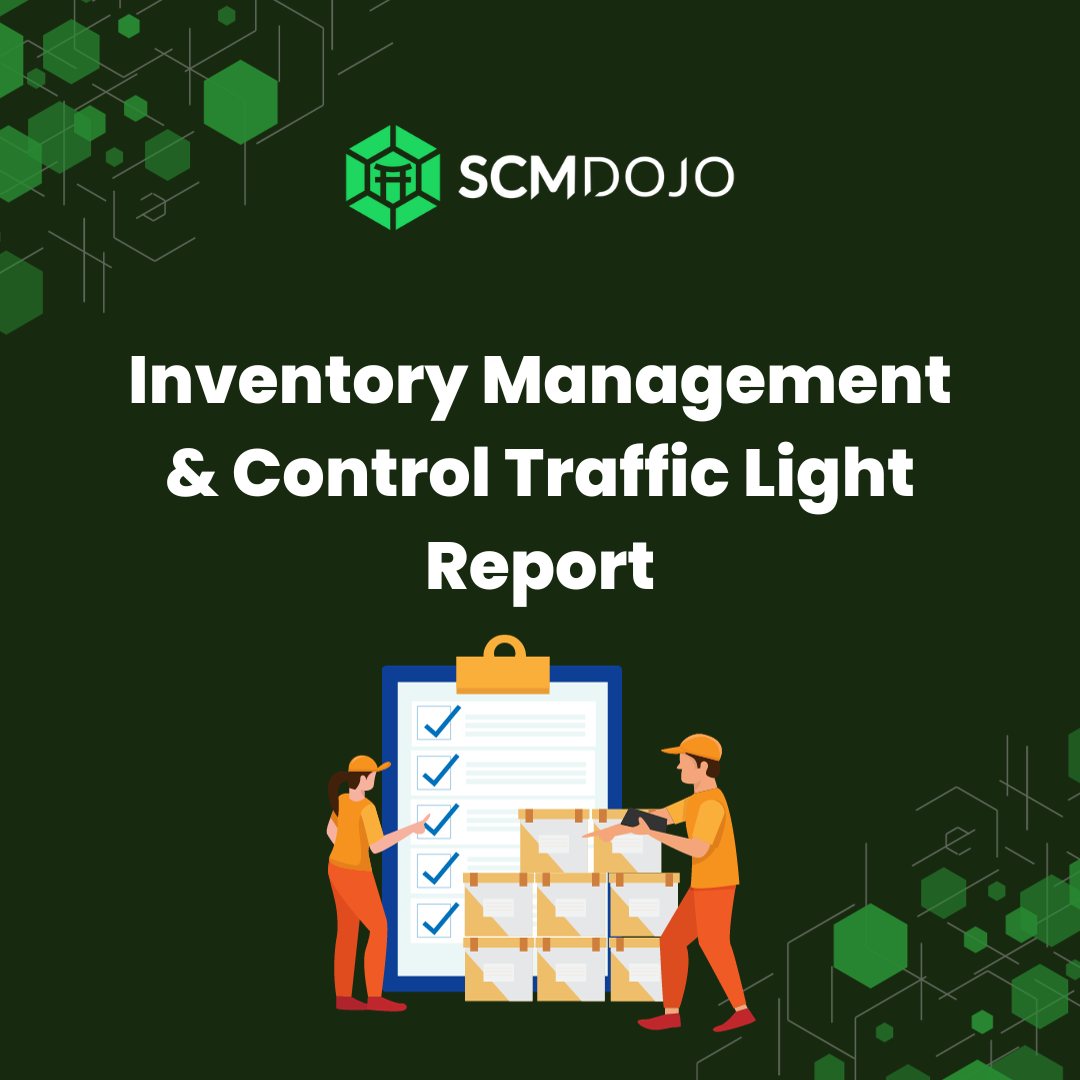Vendor Managed Inventory (VMI) optimizes the supply chain through collaboration between buyer and supplier, enhancing efficiency and cost savings.
Given the disruptive nature of supply chain dynamics, an important aspect of Supply Chain planning and control is the attempt by supply chain managers to improve supply chain performance. One way of avoiding this is to allow an upstream supplier to manage the inventories of its downstream customer.
This guide covers VMI elements, arrangements, and explores associated benefits, challenges, and risks.
Key Takeaways
- Learn the definition of Vendor Managed Inventory (VMI)
- Examples of Vendor Managed Inventory (VMI)
- The typical Vendor Managed Inventory (VMI) process
- The benefits and risks that come when implementing Vendor Managed Inventory (VMI)
Excess and Obsolete Inventory Policy Guide
What is Vendor Managed Inventory (VMI)?
Vendor managed inventory (VMI) is defined as a system of collaborative inventory management between a buyer and seller. In this arrangement, the seller continuously monitors the buyer’s inventory levels and adjusts shipments accordingly. It is a supply chain initiative where the supplier is authorized to manage inventories of agreed-upon stock-keeping units at customer locations. The benefits of VMI include improved pricing, reduced ordering and carrying costs, improved service levels and faster reaction times to changes in customer demand.
Successful retail businesses like Wal-Mart actively recognize the benefits of VMI programs.
Furthermore, in a VMI supply chain, the supplier has the liberty of controlling the downstream resupply decisions rather than filling orders as they are placed. Thus, the approach offers a framework for synchronizing inventory and transportation decisions.
Examples and Types of Vendor Managed Inventory (VMI)
- The customer, while having a vendor on-site, decides when and how much inventory to order, and assumes the responsibility for ordering and owning the inventory. (e.g. Fastener VMI)
- Vendor at the customer site, in possession of the inventory, making the inventory decisions and placing the orders, with customer taking ownership of the inventory when customer takes the item of inventory for use. (e.g. Tool Crib/Items issued through supplier owned vending machines).
- Vendor not at the customer site, has inventory at the customer site and periodically reviews (either remotely or physically) the inventory on hand and restocks the inventory when the vendor deems it necessary – a form of consigned inventory.
- The vendor, not present at the customer site, subcontracts inventory management to a third party and utilizes a third-party warehouse for holding and shipping the inventory, as seen in examples like UPS VMI.
To summarize, VMI is a collaborative strategy between a buyer and supplier to optimize the availability of products at minimal cost. Overall, inventory management cost plays a significant role in reducing supply chain cost. Specifically in the fast-moving consumer goods (FMCG) sector, inventory–turnover ratio needs to be very high in order to be able to compete in the global market.Throughout the supply chain, organizations actively use VMI to reduce inventory-related costs and maintain low inventory levels.
VMI helps organizations to reduce the inventory-associated costs by shifting the responsibility of managing and replenishing inventory to vendors.
If you wish to know more about the Inventory Planning Method in detail, click here to get the The Ultimate Guide to Inventory Planning Methods.
The Typical Vendor Managed Inventory (VMI) Process
When the customer needs product, they place an order against a supplier. The customer should be in total control of the timing and the size of the order being placed, based on one of the examples above. The customer maintains the inventory plan.
The supplier receives electronic data (usually EDI or via the internet) that tells the supplier the customer’s sales and stock levels. They can view every item that the customer carries as well as true point of sale data in most cases. The supplier is then responsible for creating and maintaining the inventory plan. Under VMI, the supplier generates the order for the replenishment of the inventory, not the customer. Hence, this is what we mean by the inventory being directly managed by the vendor.
An important point to note here is that VMI does not change the ‘ownership’ of the inventory. The ownership remains the same as it did prior to implementing the vendor managed inventory system.
Benefits of Vendor Managed Inventory (VMI)
Now, let’s explore the numerous benefits of Vendor Managed Inventory (VMI)
Benefits to the Customer
- Better visibility will make it possible to change from air-to-sea freight.
- Improvement in Fill Rates from the supplier and to the end customer as well as a decrease in stock-outs and a decrease in inventory levels.
- Planning and ordering cost will decrease due to the responsibility being shifted to the supplier.
- The overall service level is improved by having the right product at the right time.
- The supplier is more focused than ever in providing great service.
Benefits to the Supplier
- Visibility of the customers’ point-of-sale (POS) data makes forecasting easier.
-
- Visibility of the stock levels helps to identify priorities such as allowing to replenish for stock or cater to a stock-out. Before VMI, the supplier would have no visibility to the quantity and the products that are ordered. With the VMI system in place, the supplier can see the potential need for an item before the item is ordered.
Dual Benefits to both the Supplier and the Customer:
-
- Both parties are interested in giving better service to the end customer. Having the correct item in stock when the end customer needs it, benefits all parties involved.
- A true partnership is formed between the supplier and the customer. They work closer together and strengthen their ties.
-
Information to Consider
| From | To | What |
| Customer | Supplier | • Sales (actual & forecast)
•Minimum & maximum stock levels per part •Actual stock levels per part |
| Supplier | Supplier | Production order (replenishment) |
| Supplier | Customer | Shipment plan (lead times) |
Risks of Vendor Managed Inventory (VMI)
- Slow Moving items: It is not ideal to include slow moving items in the VMI model, I would not recommend especially if the item has a stock turn of 4 or less. Generally, the supplier asks the customer to take the inventory if it is not moved in 4 months maximum.
- Physical Count of Inventory: The supplier and the customer must make sure the ownership of physical stock count is defined from the outset of the agreement.
- New Product Introduction/Phase Out Items: I have found it is quite a headache to manage to manage New Product Introduction and Phase Out plans for inventory on ramp down. This is a scenario which needs special communication.
- Monthly Exception: We like to trust the data in our ERP or Inventory management system, but discrepancies are bound to occur over long periods of time. Therefore, I strongly recommend monthly exception reporting to align physical inventory between the supplier and the customer.
To summarize…
Vendor-managed inventory (VMI) is a collaborative strategy between a buyer and supplier to optimize the availability of products at minimal cost. Overall, inventory management cost plays a significant role in reducing supply chain cost.
VMI is a logistics distribution strategy through which the supplier manages inventory at customers’ sites and decides on replenishment policies, subject to stipulated levels of availability and service. The supplier benefits by reducing its inventory levels, reducing customers’ demand variability, and improving routing strategies; customers benefit by reducing resources dedicated to manage inventories and by decreasing their stock-outs, thus increasing their revenues.
MRPeasy – Fast and easy production planning
Recommended Reading
Vendor Managed Inventory: Exploring objectives, benefits and shortcomings of the business concept
About the Author- Dr Muddassir Ahmed
Dr MuddassirAhmed is the Founder & CEO of SCMDOJO. He is a global speaker, vlogger and supply chain industry expert with 17 years of experience in the Manufacturing Industry in the UK, Europe, the Middle East and South East Asia in various Supply Chain leadership roles. Dr. Muddassir has received a PhD in Management Science from Lancaster University Management School. Muddassir is a Six Sigma black belt and founded the leading supply chain platform SCMDOJO to enable supply chain professionals and teams to thrive by providing best-in-class knowledge content, tools and access to experts.
You can follow him on LinkedIn, Facebook, Twitter or Instagram








